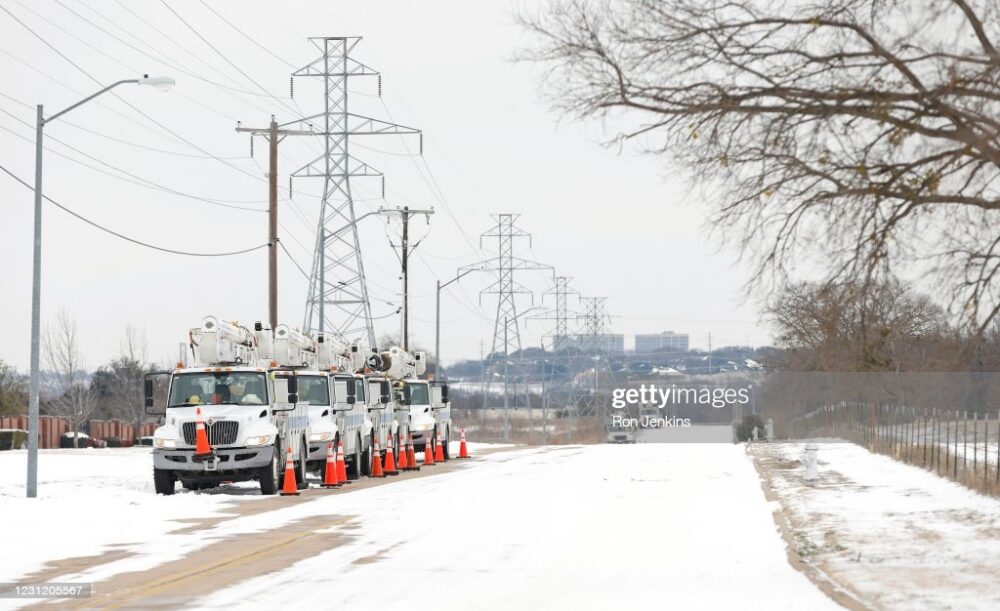Early last Monday, amidst a historic freeze, the Texas power grid found itself “seconds and minutes” away from near total collapse. Had a blackout of this magnitude happened, almost all of Texas would have lost heat and power for months—an unprecedented humanitarian disaster.
Thankfully, the worst outcome was narrowly avoided. Yet what actually happened was not much better. Widespread blackouts left 4 million Texans without power and at least 26 people dead. Thousands remain with no running water and countless others are struggling to find shelter and food.
Things could have gone differently had decisions made decades ago not left Texas infrastructure woefully unequipped to deal with the cold weather.
In 1999, the Texas legislature privatized the state’s power grid, creating a patchwork grid of competing providers, each trying to deliver energy for the lowest price possible. The market discouraged costly investments for the future—especially for unlikely but potentially catastrophic events like a freezing winter in Texas. As a result, power lines were left without insulation, and wind turbines were built without de-icing technology.
ERCOT, the non-governmental regulatory body for Texas’ power grid, failed to mandate reserves of extra energy in case of emergencies. Moreover, to avoid federal regulation, Texas long ago isolated itself from regional power grids, limiting their ability to import electricity from other states during times of crisis.
In normal times, these deregulatory measures made Texas one of the cheapest states in the energy market. But in the event of a rare (though not unprecedented—see 2011) winter storm, Texas’ failure to winterize their grid took dozens of lives, cost taxpayers tens of billions, and straddled many customers with thousands of dollars in energy bills amidst surging demand.
1. What does this mean for the rest of the United States?
It is easy to paint what happened to Texas this week as simply a consequence of the state’s unique history as the “Lone Star Republic,” and their associated distaste for government regulations.
But in truth, almost every other state in the Union is vulnerable to comparable disasters, due to climate change and the increased frequency of heat waves and cold snaps. The outages caused by last week’s winter storm went far beyond Texas, leaving many residents in Louisiana and Oklahoma without electricity and heat. And nationwide extreme weather events have increased major power outages across the United States by 67% since the year 2000.
Many of these failures are due to the fact that at the time most of our key infrastructure was built, it was assumed that future climate conditions would largely mirror those of the past. This was obviously incorrect.
2. How do we avoid future disasters, and address the vulnerabilities of our power grids?
Current infrastructure needs to be updated or, in some cases, rebuilt to ensure it can withstand new environmental pressures.
In the case of our power grids, many have begun to call for a national energy network— a plan supporters claim will create jobs, make our grids more resilient to storms, and allow more reliance on renewable energy sources.
Advocates for a national system point to the interstate highway system—in which interstate roads are federally funded and subject to certain national regulations, but owned by states—as a model for future infrastructure efforts. By connecting the Eastern, Western, and Texas energy grids, the U.S could create an interconnected national network.
Beyond climate change, increasing the resilience of our energy supply will be key to defending the U.S against some of our greatest national security threats. The NSA has long warned power grid operators of an increased likelihood of cyber attacks from adversaries like Russia and China.
In 2019, the first-ever cyber attack on the US grid managed to create small blind spots at a grid control center in the Western U.S. Later, the massive Solar Winds attack infected over 15 energy and manufacturing entities with malware, potentially compromising vital infrastructure. These attacks are likely to increase as technology becomes more advanced. We must do all we can to protect our power grids from foreign attack.
Ultimately, we must ensure that American energy infrastructure is prepared to withstand the environmental and technological challenges the next generation will face. If not, the heavy human and monetary costs of this week’s blackouts in Texas may pale in comparison to those of the future.





